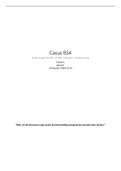Essay
BTEC Applied Science - Unit 6 Learning Aim A
- Institution
- PEARSON (PEARSON)
BTEC Level 3 Applied Science Unit 6 Learning Aim A - Undertake a literature search and review to produce an investigative project proposal Distinction Grade Received How does cost affect the effectiveness of different disinfectants against E. coli
[Show more]












